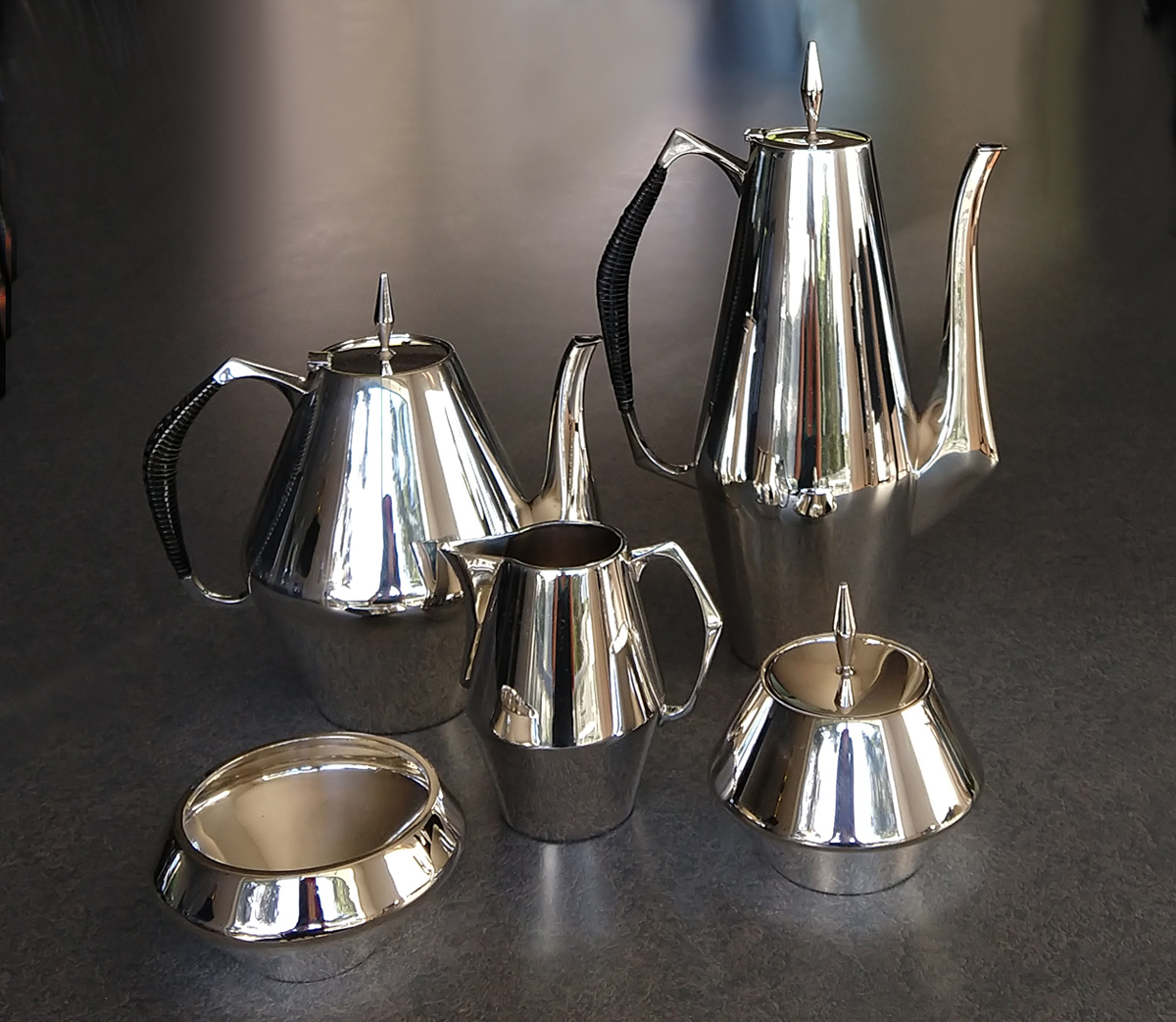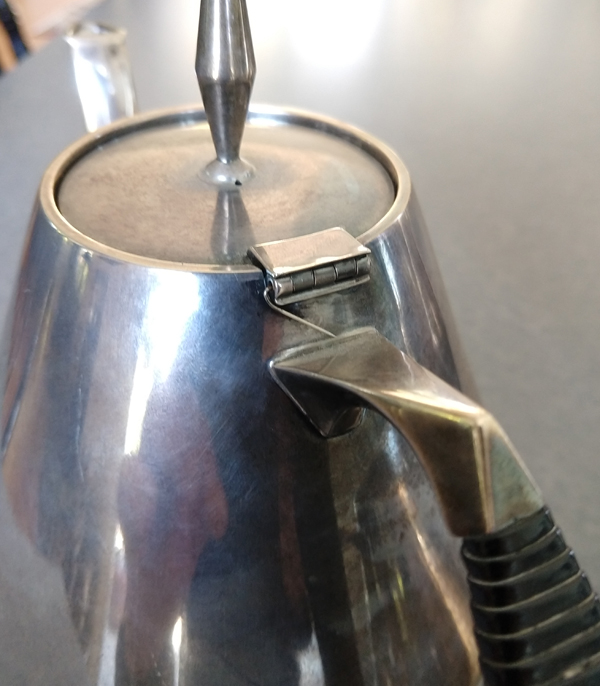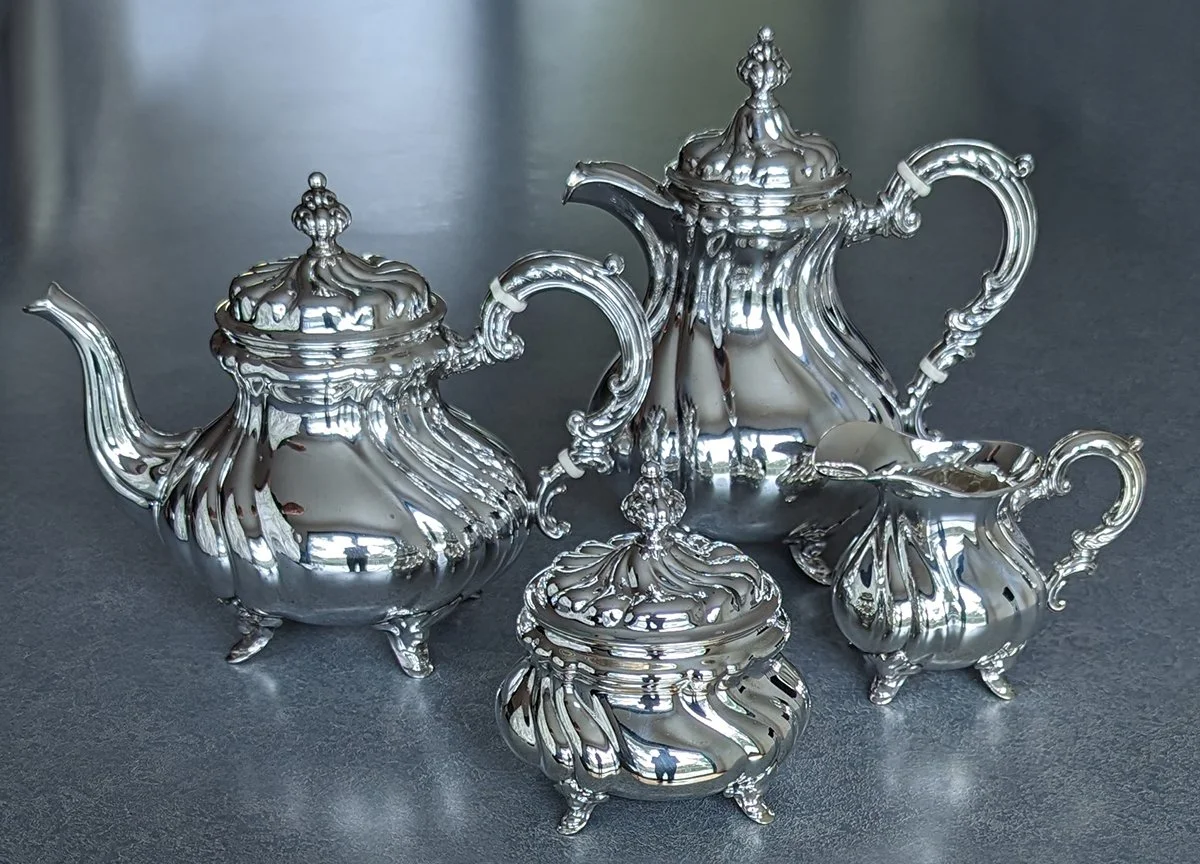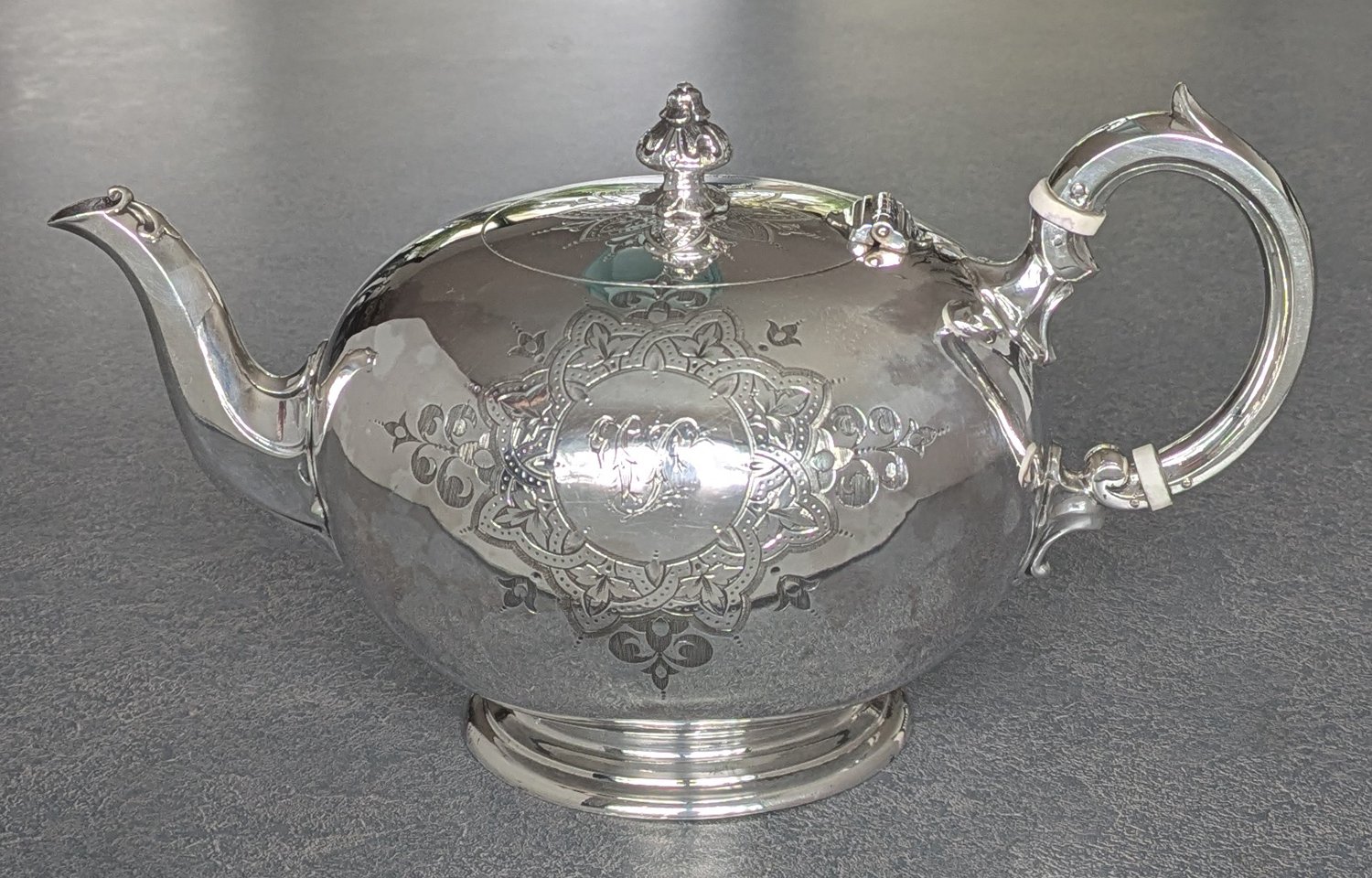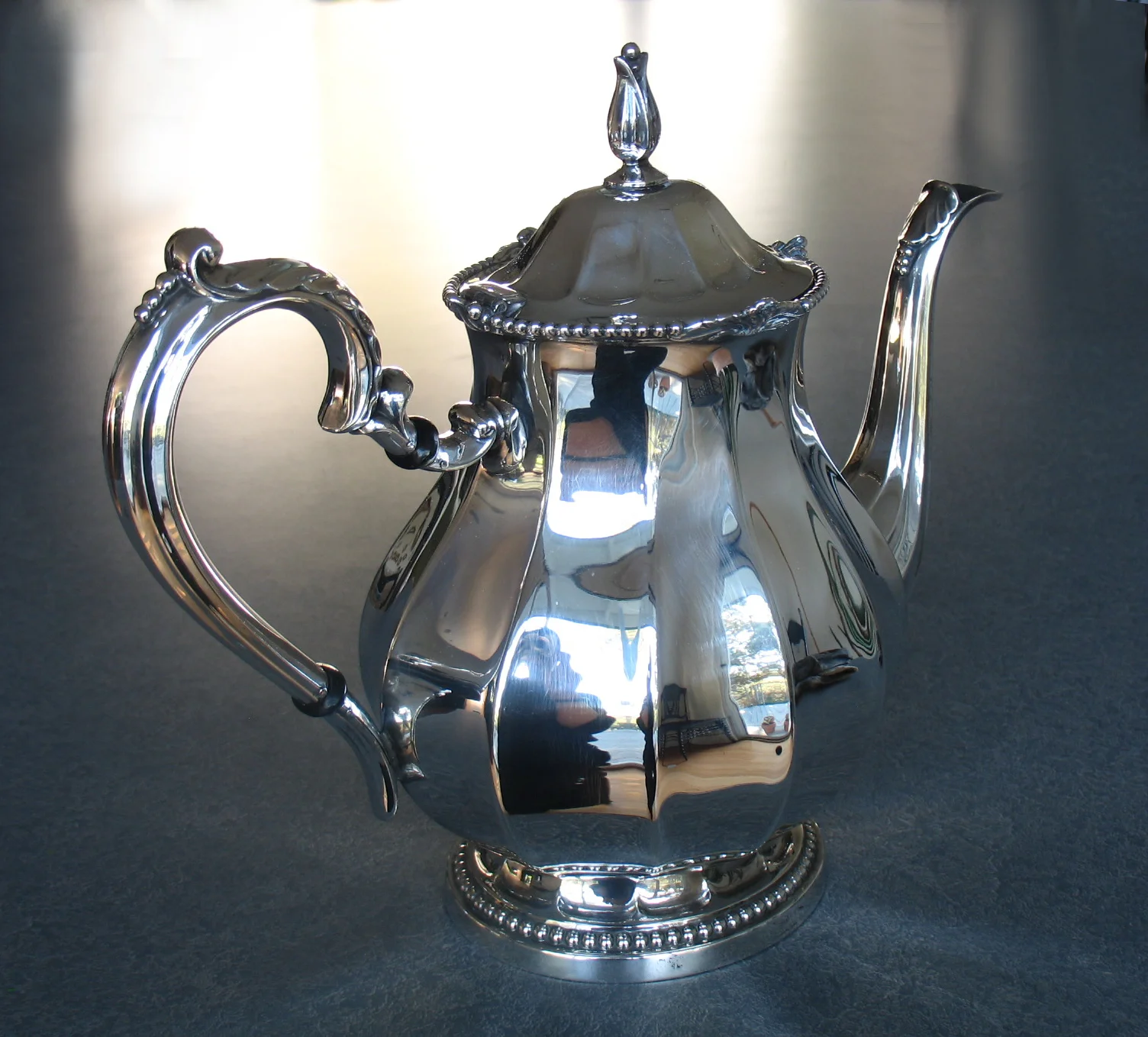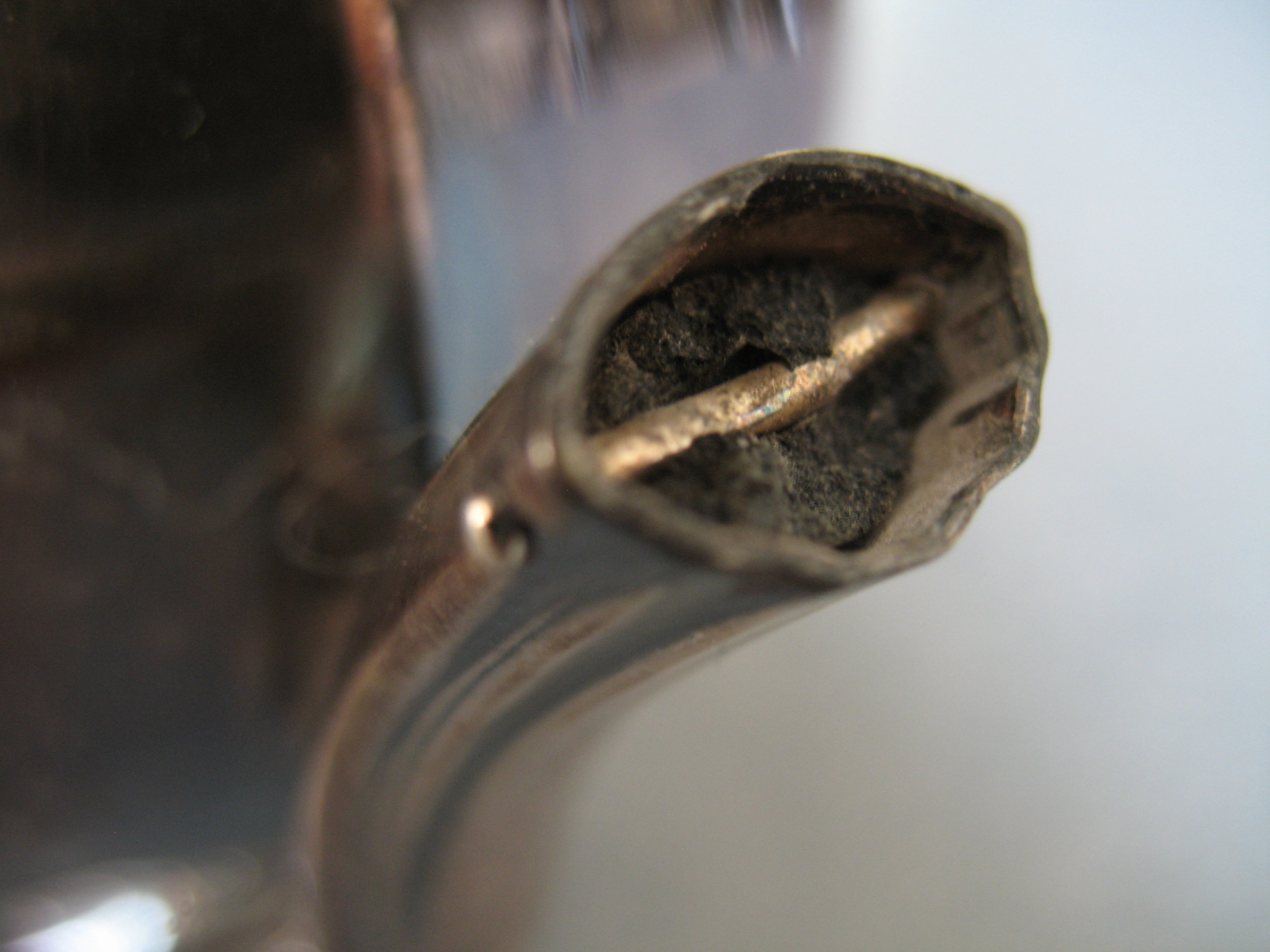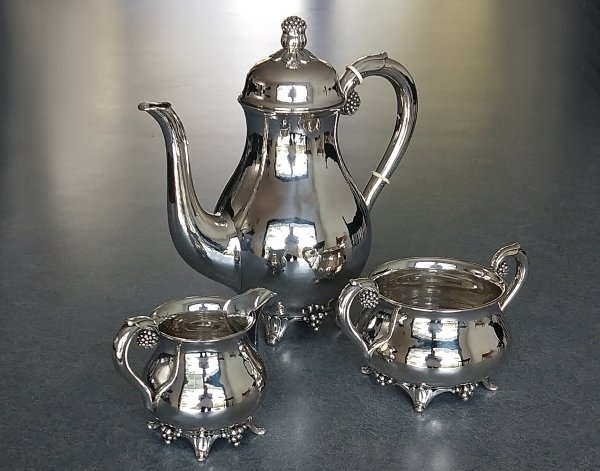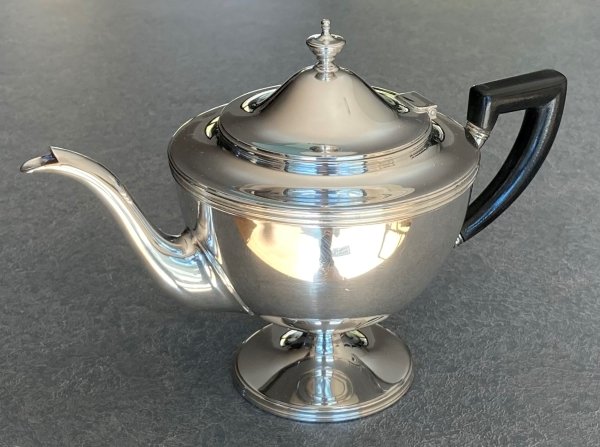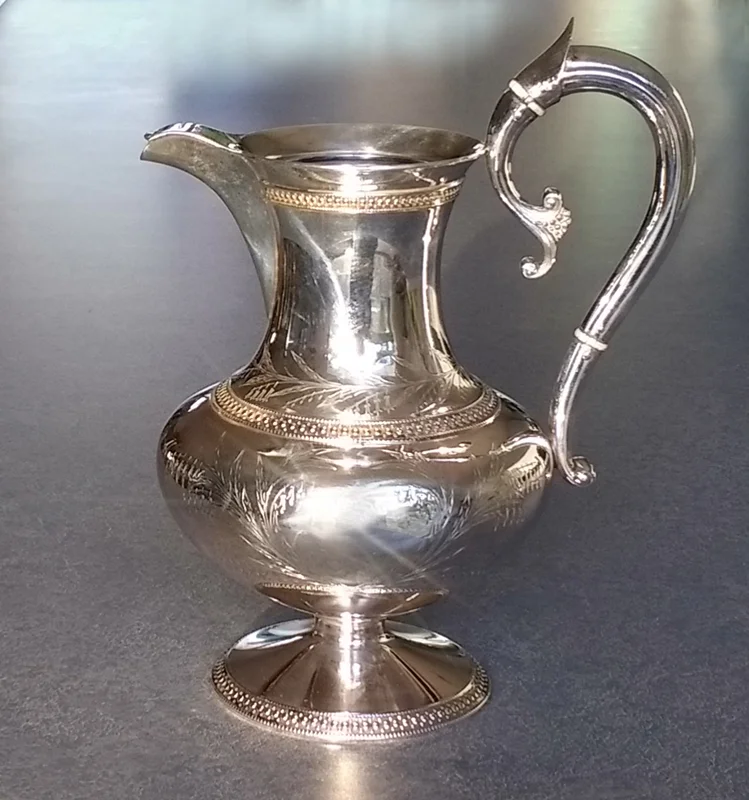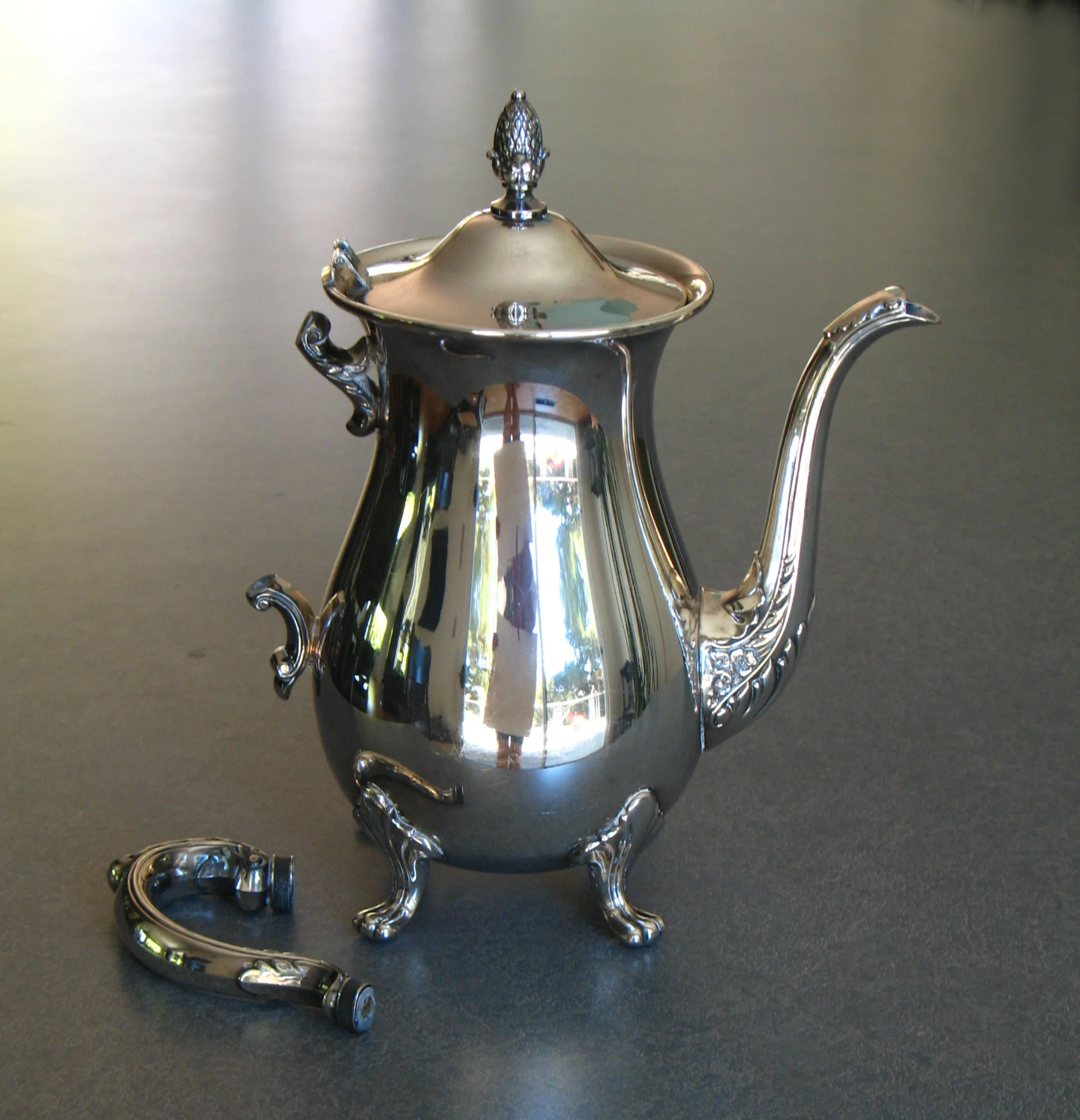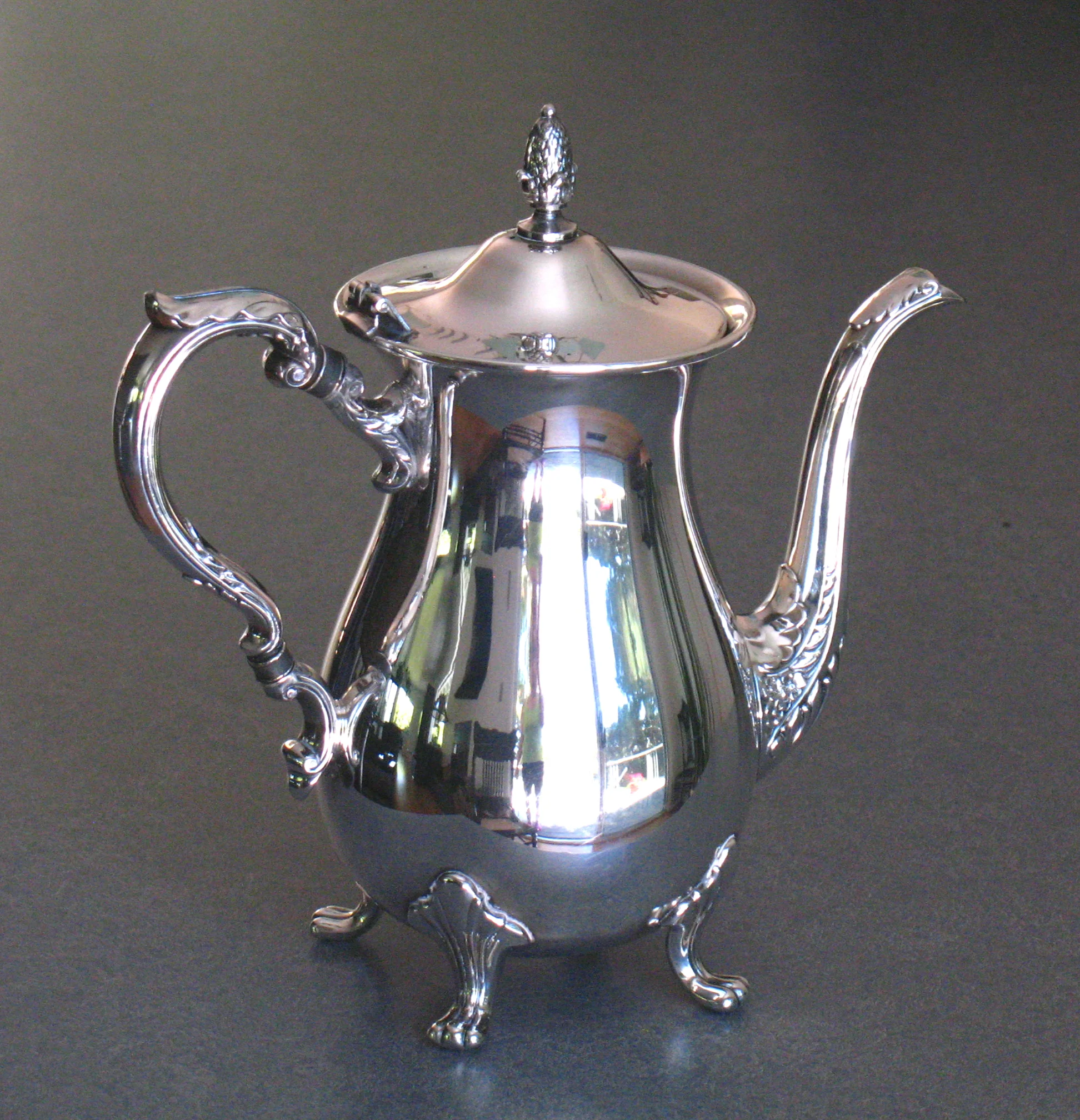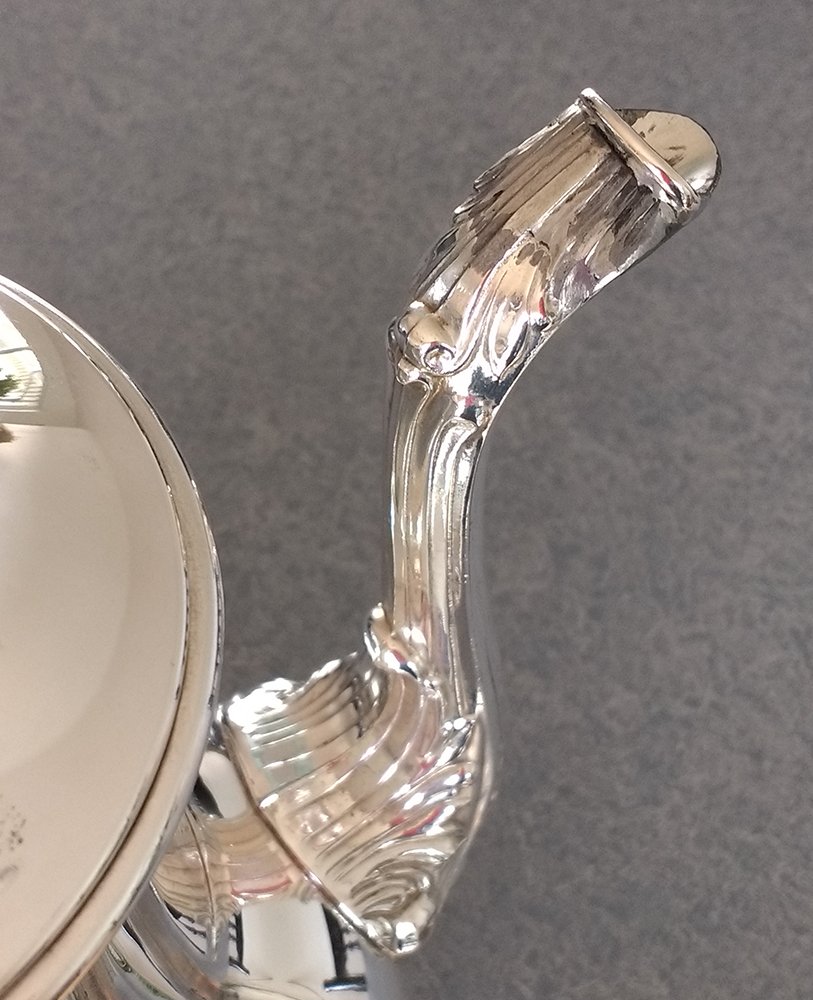Coffeepots and Teapots Repairs
Removing Dents from Sterling silver
Coffeepots & teapots
Sterling silver Diamond 20th-century tea and coffee service
This sterling silver service was designed by John Prip for Reed and Barton in the 1960s. It was intended to coordinate with the Diamond flatware pattern (circa 1958). This set arrived with dents in the teapot, creamer, and waste bowl. In the four photos below, you can see a close-up of the dents before they were removed. The teapot was also missing the hinge pin and arrived with a sewing pin in its place. After the repairs, the entire set was polished (shown in the above photo.)
This Diamond Teapot (above) arrived with the side pushed in at the handle, a dent in the other side, and missing the hinge pin. In the above photos, you can see the original rattan handles.
In the photos (below) you can see the dents in the Diamond creamer and the round edge of the waste bowl.
Sterling teapot insulator repair
STERLING SILVER TEAPOT Ivory INSULATORS REPLACEMENT
Sterling silver teapots and coffeepots have insulators that separate the handle from the body so the handle does not get hot. The insulators were traditionally hand-carved ivory, ebony, or wood.
This early 20th-Century tea set had a coffeepot and teapot that needed new insulators. The old insulators, made of wood with an ivory ring, had dried out and loosened. I hand-carved new insulators out of imitation ivory, which was particularly challenging because the construction of this set was very unusual and the sockets were asymmetrical. Every insulator replacement job is highly customized and time-consuming work, however, the improved functionality and appearance are often worth it. The photo on the left shows the insulator before the replacement and the photo on the right shows the new insulator in the polished teapot.
English Sterling Silver Teapot with new hand carved insulators
This English silver teapot arrived with broken ivory insulators, and dents in the side. Removing the dents was not a concern (except for the years of tea crud on the inside.) The real challenge with this repair was carving new insulators from imitation ivory as the sockets were small and the shape was very complex.
STERLING SILVER TEAPOT Ebony INSULATORS REPLACEMENT
This sterling silver teapot arrived with the ebony insulators broken. You can see this in the close-up images. Restoring the insulators is expensive. There are no insulator parts to purchase. For this coffeepot, I carved black Delrin, a tough industrial plastic. Carving new insulators takes a tremendous amount of time. Each insulator needs to be hand carved to fit inside the handle just right. The larger image shows the new insulators with the handle attached properly.
Sterling Silver Coffeepot Ivory Insulators replacement
The old ivory insulators on this teapot were broken and needed to be replaced. Always keep the broken pieces. The broken halves were glued back together and were used as a model for carving the new insulators. For ivory insulators, an imitation ivory plastic is a suitable replacement material. The photo above on the left shows the new imitation ivory insulators before they were polished and set. The photo on the above right shows the coffeepot with the new insulators riveted in place.
Danish Silver Teapot Wood and Ivory Insulator Resetting
This Danish silver teapot arrived with two large dents and a wiggly handle. Depending on the location of the dent, I have to remove the teapot or coffeepot handle in order to push the dents out. When I removed the handle on this teapot, I discovered why it had become loose.
Once in a great while, I see coffeepots and teapots with wooden insulators. This teapot had wood insulators with a thin ring of ivory around the middle. The wood had shriveled up over time, and the rivets no longer held the handle in place securely. After removing the dents in the teapot, I drilled and riveted the wooden insulators in place with a slightly wider gauge sterling silver wire to make the handle secure.
It is a good idea to oil wooden insulators with a drop of mineral oil or butcher block oil to prevent them from drying out and shrinking.
Loose Handle Repair
Sterling Silver Teapot with Loose Handle
When the handle on your teapot starts to wiggle, it’s better to stop using it before the insulators or handle break. This sterling silver teapot was sent to me after the owner noticed the ebony handle was starting to move just a bit. The rivets had become bent inside the handle and were too short to hold it in place.
The old rivets were removed and the handle was reset with new rivets in newly drilled rivet holes.
The handle was secured before the ebony started to crack and break, saving this teapot from a very painful, expensive repair.
Sterling teapot Lid Repair
STERLING TEAPOT with damaged lid, spout, and dents restored
This sterling teapot is restored after very serious damage during a fire. The worst problem was that the sterling teapot fell and the lid was stepped on during the fire. In addition, the side was also dented and the tip of the spout was damaged.
It took great skill and three weeks to repair this teapot. I like to work on such difficult repairs very slowly as it can be very challenging to fix a lid that is stepped on. The damaged spout and dent on the side are more common repairs.
The restoration of this sterling silver teapot turned out so well that it is impossible to tell that it was ever repaired.
Sterling Coffeepot Base Repair
Sterling silver coffeepot with damaged base restored
This sterling silver coffeepot arrived with the base wrinkled, squashed, and badly damaged because it was dropped and landed on the base. The photo (left) doesn’t even begin to show the devastating damage. I was able to remove the wrinkles and restore the base so that the coffeepot sits flat. The customer said, “My coffee pot has arrived, and it is beautiful again. Thank you so much for restoring it for me. “
Sterling teapot Dent & Handle Repair
sterling silver 19th-century coffeepot - Dents removed and handle repaired
This sterling silver 19th-century teapot had a couple of dents, and the handle was "wiggly." The goal was to preserve the original ivory insulators as the customer was not intending to use this coffeepot except as decoration.
The rivets in the ivory insulators were poorly done in a previous repair using brass wire and steel wire instead of sterling. Two of the pins into the ivory insulator were missing. I drilled out the old brass and steel pins, which was really challenging. I then replaced all four pins in the ivory insulators with sterling silver wire.
The dents in this coffeepot were carefully removed with skill, patience, and strength. I never hammer dents, but push them out from the inside. Finally, the coffeepot was lightly polished.
Click on this link to see more dent repairs.
Silverplate Coffeepot & Teapot repairs
Leak repair in coffeepots, teapots, and hot water kettles
Leaks are difficult to repair. Even the tiniest pinhole, invisible to the naked eye, can leak a drop of water. Water-tight is the goal. Most of the time there is no other option but to repair the leak on the outside of the vessel. I try my absolute best to make the repair as attractive as possible. Sometimes, I can use my new state-of-the-art TIG welder to repair the hole, working at a microscopic level. On the kettle to the right, I added an attractive wire below the spout to conceal the repair.
SILVER PLATE COFFEEPOT REPAIR OF THE HANDLE insulator
The construction of the insulators of silver plate teapots and coffeepots is different than on sterling. They are typically made of a prefabricated sandwich of synthetic material and metal and can’t be replaced. I have to reuse the old insulator and be careful not to burn it while soldering it back in place. Usually, both insulators break at the same time. For the most attractive and strongest repair of silver plate insulators, I will use sterling silver sheet to protect the insulator material while resoldering. This is not easy to do but will result in a functional and attractive repair without ruining the silver plating.
Silverplate Coffeepot knob reattached to lid, Hinge repair, and spout reconstruction
This silverplate teapot arrived with the knob broken off the lid and the hinge was broken as well. The damaged lid was a pretty easy, straightforward repair. The real challenge was that the tip of the spout was broken off into about five separate little broken pieces. In the right photo, you can see that that spout is back together. I fused the separate pieces back together and carved the rebuilt spout to camouflage the extensive reassembly effort. Then I added a sterling silver wire at the edge to strengthen and unify the appearance.
Since this piece was not silver-plated after I finished reconstructing the spout, the repair does show because the solder is a slightly different color. Otherwise, the repairs turned out very well. This coffeepot has a lot of sentimental value that can not be replaced.
The customer said, "I received the teapot in excellent condition and wanted to thank you again for the excellent repair work and customer service you provided. I am so pleased to have my mom's piece back and restored to near perfection. You truly are a skilled artist and silversmith."
Art Deco Coffee urn Repair
URN USED FOR HOT WATER, TEA OR COFFEE
This Art Deco urn was brought in for repair because the spout had broken off. This urn is probably an Art Deco (circa 1930 -1932) piece judging from its design and the nickel plate finish. There are no replacement parts available for pieces like this. Working carefully to avoid damaging the nickel plating, I was able to repair the spigot. Nickel plate can be polished very nicely by hand with Simichrome All Metal Polish and a soft cloth. Use Q-tips to get into the corners and edges.
CAUTION: Do not use Simichrome Polish on silverplate items.
